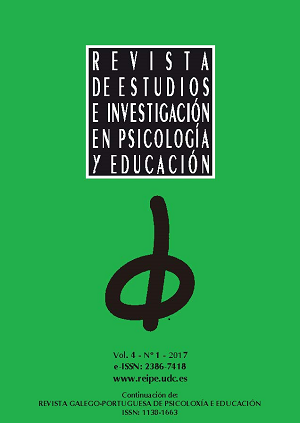Approach to the concept of emotionality. The emotional stereotype of sexism
Main Article Content
Abstract
Keywords:
Downloads
Article Details
References
Aquino, A. E. (2003). Diferencias de género y edad en la inteligencia emocional de un grupo de Internautas. Unpublished Thesis. Universidad Inca Garcilaso de la Vega. Facultad de Psicología y Ciencias Sociales. Lima-Peru.
Argyle, M. (1990). The psychology of interpersonal behaviour. Harmondsworth, UK: Penguin.
Baron-Cohen, S. (2003). The essential difference: men, women and the extreme male brain. London: Allen Lane.
Brody, L. R., y Hall, J. A. (1993). Gender and Emotion. In Lewis, M. y Haviland, J., (Eds.), Handbook of Emotions. Nueva York: Guilford Press.
Candela, C., Barberá, E., Ramos, A., & Sarrió, M. (1997). Inteligencia emocional y la variable Género. REME. Revista Electrónica de La Motivación Y Emoción, 5(10). http://reme.uji.es/articulos/acandc2272105102/texto.html
Carretero-Bermejo, R. (2011). Sexo, sexismo y acoso escolar entre iguales. Revista Complutense de Educación. 22(1), 27-43. https://doi.org/10.5209/rev_RCED.2011.v22.n1.2
Diaz-Aguado, M.J. (2006) Sexismo, violencia de género y acoso escolar. Propuestas para una prevención integral de la violencia. Revista de Estudios de Juventud, 73, 38-57. http://www.educarenigualdad.org/media/pdf/uploaded/old/Doc_175_revista_juventud.pdf
Díaz-Aguado, M. J., Martínez, R., y Martín, J (2010). Estudio estatal sobre la Convivencia Escolar en la Educación Secundaria Obligatoria. Madrid: Ministerio de Educación. http://www.madrid.org/dat_norte/WEBDATMARCOS/supe/convivencia/estudio.estatal2010.pdf
Díaz-Lázaro, C. M., y Toro-Alfonso, J. (2014). La contribución estadística del autoritarismo, la dominancia social, la empatía, y el materialismo a la varianza del prejuicio intergrupal en Puerto Rico. Revista Puertorriqueña de Psicología, 25(1), 354-137. http://pepsic.bvsalud.org/scielo.php?script=sci_arttext&pid=S1946-20262014000100008
Expósito, F., Moya, M., y Glick, P (1998). Sexismo ambivalente: Medición y correlatos. Revista de Psicología Social, 13(2), 159–169. https://doi.org/10.1174/021347498760350641
Ferragut, M., Blanca, M. J., and Ortiz-Tallo, M. (2013). Psychological values as protective factors against sexist attitudes in preadolescents. Psicothema, 25(1), 38-42. http://doi.org/10.7334/psicothema2012.85
Fernández-Berrocal, P., Extremera, N., & Ramos, N. (2004). Validity and reliability of the Spanish modified version of the Trait Meta-Mood Scale. Psychological reports, 94(3), 751-755. https://doi.org/10.2466/pr0.94.3.751-755
Garaigordobil, M. (2013). Sexism and alexithymia: Correlations and differences as a function of gender, age, and educational level. Anales de Psicología, 29(2), 368–377. https://doi.org/10.6018/analesps.29.2.132261
Garaigordobil, M., y Aliri, J. (2013). Relaciones del Sexismo con justificación de violencia y con otras formas de prejuicio como la dominancia social y el autoritarismo. Estudios de Psicología, 34(2). http://www.tandfonline.com/doi/abs/10.1174/021093913806751384?journalCode=redp20
Gartzia, L. (2011). Nuevos modelos de gestión: de pensar en masculino a pensar en andrógino. Boletín de Estudios Económicos, 203, 299–314. www.emozioak.net/index.php/en/otros/item/download/480.html
Glick, P., & Fiske, S. T. (1996). The ambivalent sexism inventory: Differentiating and Hostile Benevolent sexism. Journal of Personality and Social Psychology, 70, 491–512.
Glick, P., & Fiske, S. T. (1997). Hostile and Benevolent sexism. Measuring ambivalent sexist attitudes. Psychology of Women Quarterly, 21, 119-135. https://doi.org/10.1111/j.1471-6402.1997.tb00104.x
Gómez-Berrocal, C., Cuadrado, I., Navas, M., Quiles, M. N., y Morera, M. D. (2011). Sexismo hostil y benevolente: Dimensiones de comparación intergrupal, imagen de los subtipos de mujer y autoimagen del endogrupo. Revista de Psicología Social, 26(1), 45–62. https://doi.org/10.1174/021347411794078453
Gorostiaga, A., Balluerka, N., y Soroa, G. (2014). Evaluación de la empatía en el ámbito educativo y su relación con la inteligencia emocional. Revista de Educación, 364, 43- 61. https://doi.org/10.4438/1988-592X-RE-2014-364-253
Hall, J. A. (1978). Gender effects in decoding nonverbal cues. Psychological Bulletin, 85, 845–857. https://doi.org/10.1037/0033-2909.85.4.845
Hall, J. A. (1984). Nonverbal sex differences: Communication accuracy and expressive style. Baltimore: Johns Hopkins University Press.
Hargie, O., Saunders, C., y Dickson, O. (1995). Social skills in interpersonal communication. London: Routledge.
Lewis, R. A. (1978). Emotional intimacy among men. Journal of Social Issues, 34. 108-121. https://doi.org/10.1111/j.1540-4560.1978.tb02543.x
López-Cepero, J., Rodríguez-Franco, L., Rodríguez-Díaz, F. y Bringas, C. (2013). Validación de la versión corta del Social Roles Questionnaire (SRQ-R) con una muestra adolescente y juvenil española. Revista electrónica de metodología aplicada. 18(1), 1-16. https://doi.org/10.17811/rema.18.1.2013.1-16
Mayer, J. D., y Salovey, P. (1997). What is emotional intelligence? Emotional development and emotional intelligence: Implications for educators. New York: Basic Books. http://ei.yale.edu/publication/emotional-intelligence-4/
Merino, E., Martínez, M., y Díaz-Aguado, M. J. (2010). Sexismo, Inteligencia Emocional y Adolescencia. Revista de Psicología Educativa, 16(1), 77–88. https://doi.org/10.5093/ed2010v16n1a7
Roets, A., Van Hiel, A., & Dhont, K. (2012). Is sexism a gender issue? A motivated social cognition perspective on men’s and women’s sexist attitudes toward the own and other gender. European Journal of Personality, 26, 350-359. http://doi.org/10.1002/per.843
Rodríguez, M. J., Lameiras, M., Carrera, M. V., y Faílde, J. M (2009). Aproximación conceptual al Sexismo ambivalente: Estado de la cuestión. SUMMA Psicológica UST, 6(2), 131-142. http://www.summapsicologica.cl/index.php/summa/article/view/68/68
Rosenthal, R., Hall, J. A., DiMatteo, M. R., Rogers, P. L., y Archer, D. (1979). Sensitivity to nonverbal communication: The PONS test. Baltimore: Johns Hopkins University Press.
Tapia, M. y MarshaII, G. E. (2006). The effects of sex and grade-point average on emotional intelligence. Psicothema, 18, 108-111. http://www.psicothema.es/pdf/3284.pdf
Salovey, P., & Grewal, D. (2006). Inteligencia Emocional. Mente y Cerebro, 16, 10-20. http://amscimag.sigmaxi.org/4Lane/ForeignPDF/2005-07GrewalSpanish.pdf
Salovey, P., & Mayer, J. D. (1990): Emotional intelligence. Imagination, Cognition, and Personality, 9(3), 185-211. http://citeseerx.ist.psu.edu/viewdoc/download?doi=10.1.1.385.4383&rep=rep1&type=pdf
Sánchez, M. T., Fernández-Berrocal, P., Montañés, J., y Latorre, J. M. (2008). ¿Es la inteligencia emocional una cuestión de Género? Socialización de las competencias emocionales en hombres y mujeres y sus implicaciones. Revista Electrónica de Investigación Psicoeducativa, 6(2), 455–474. http://www.investigacion-psicopedagogica.org/revista/new/ContadorArticulo.php?253
Sánchez-Núñez, M. T., Fernández-Berrocal, P. y Latorre, J. M. (2013). Assessment of emotional intelligence in the family: influences between parents and children on their own perception and that of others. The Family Journal, 21, 44-52. https://doi.org/10.1177/1066480712456821
Scandroglio, B.; López, J.S.; San José, M.C. (2008). La Teoría de la Identidad Social: una síntesis crítica de sus fundamentos, evidencias y controversias. Psicothema, 20(1), 80-89. http://www.psicothema.com/pdf/3432.pdf
Zakrisson, I., Aderzén, M., Lenell, F., y Sandelin, H. (2012). Ambivalent sexism: A tool for understanding and improving gender relations in organizations. Scandinavian Journal of Psychology, 53, 64-70. https://doi.org//10.1111/j.1467-9450.2011.00900.x



